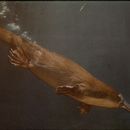Biology
provided by Arkive
During the hours of daylight, the platypus remains in an individual, oval-shaped burrow, dug three to eight metres into an earth bank (8). Emerging at dusk, it spends most of the night foraging in shallow water for bottom-dwelling invertebrates, such as crustaceans, worms and molluscs and the larvae of freshwater insects (3) (8). Throughout the 20 to 40 second dives, the platypus probes the muddy bottom with its highly sensitive bill, aided by an array of electro-receptors capable of detecting the small muscle activity of prey (3) (6) (7) (8).
Although platypus home ranges often overlap, these solitary animals generally only come together to mate (7) (8). Breeding occurs from late winter to spring, with mating taking place in the water (3) (8). Around 21 days after mating, the female lays from one to three, leathery-shelled eggs in an elaborate nesting burrow, up to 30 metres long and comprised of multiple chambers (6) (7) (8). The tiny, naked young hatch after an incubation period of just 10 days, but remain in the burrow for three to four months, during which time they feed on milk sucked from the fur around the female's mammary glands (3) (6) (8). Emerging from the burrow in summer, the young enter the water and begin to feed on the benthic organisms on which the adults thrive (3). In the wild the platypus may live for up to 20 years (1).
Conservation
provided by Arkive
The platypus is legally protected in all the states in which it occurs and populations are found in several protected national parks and reserves. Furthermore, fishing regulations, including the use of nets with larger mesh sizes, have helped to reduce the number of accidental deaths. In the absence of a reliable data, it is vital that research is carried out to determine baseline platypus population levels and trends (1) (6). This is to be supported by further research into platypus biology and the effects of human activities on the species, which will be used to inform conservation strategies (6). In addition, given the current threat of the spread of Mucormycosis, research into the fungal disease is also considered a huge priority (1) (9).
Description
provided by Arkive
So seemingly incongruous was the appearance of platypus specimens shipped to England at the end of the 18th century, that many observers assumed it was the fraudulent work of a skilled taxidermist (3) (4) (5). Even after the specimens were found to be authentic, it was sometime before scientists concluded that the 'amphibious mole' was in fact a mammal, albeit the most evolutionary distinct mammal alive (3) (5) (6). The distinctive features that make the platypus so instantly recognisable are its duck-like bill, dense, waterproof fur, webbed feet, and broad, flattened tail (3) (7) (8). The plush pelage that covers its stream-lined body is deep brown above, and silvery grey to yellow underneath (3) (6) (8). The limbs are extremely short, with the heavily webbed front-feet providing propulsion through water, while the hind-feet act more like rudders (3). In male platypuses, the rear ankles are equipped with a horny spur connected by a duct to venom gland, which is used to inflict wounds on natural predators and other males (3) (7) (8). Although, the characteristic muzzle of the platypus resembles that of a duck, it is actually soft and rubbery, and contains no true teeth (3) (6) (8).
Habitat
provided by Arkive
Found mainly in streams and rivers with earth banks suitable for burrows, but also occurs in lakes and farm dams (3) (6) (8).
Range
provided by Arkive
The platypus is endemic to Australia, where it occurs in eastern Queensland and New South Wales, eastern, central and south-western Victoria, and throughout Tasmania. In addition there is an introduced population on Kangaroo Island, South Australia (1).
Status
provided by Arkive
Classified as Least Concern (LC) on the IUCN Red List (1).
Threats
provided by Arkive
Although the platypus was hunted intensively for its fur until the early 20th century, its population has recovered well and is now thought to be fairly abundant (1) (6). However, owing to the species' specialised habitat requirements, it is seen as being increasingly vulnerable to the effects of habitat change (3) (8). In particular, one of the major concerns is the impact of reduced stream and river flow, resulting from prolonged periods of drought and the industrial and domestic extraction of water. Paradoxically, excessive flooding in the past has also been responsible for increased mortality and a decline in the number of young being born. In parts of its range, accidental drowning in nets and traps set for fish and crustaceans is a further problem (1) (6).
There are also growing concerns about the potential impact of a fungal disease, Mucormycosis, currently restricted to Tasmania. Platypuses that become infected with the disease develop ulcers on their body that can lead to death, due to secondary infection and an inability to control body temperature. It is not yet known what impact the disease is having on the abundance and distribution of the Tasmanian platypus population (8) (9).

